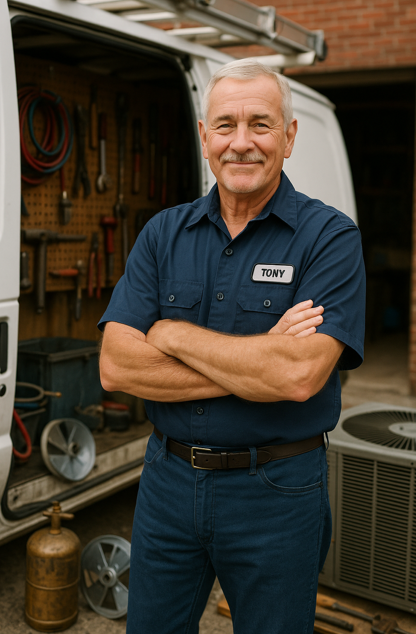Hey, Tony Here — Let’s Find Your Furnace Match! 🔧
When it comes to picking an 80,000 BTU gas furnace, it’s not just about size or price. You want a system that fits your home’s heating needs like a glove — efficient, reliable, and built to last.
Whether you’re upgrading from an older furnace or installing new in a freshly built home, making the right choice upfront saves you headaches, wasted energy, and costly repairs down the road.
In this guide, I’ll walk you through all the key factors you need to consider — from calculating the proper furnace size to understanding energy efficiency ratings, choosing R-32 compatible systems, and tips for hiring the right installer.
Ready? Let’s get into it.
Step 1: Understanding Furnace Sizing — Why 80,000 BTU Might Be Perfect for You 🏠🔥
BTUs (British Thermal Units) measure the heat your furnace produces per hour. Picking the right BTU rating is crucial because:
-
Too Small: Your furnace will struggle to keep up during cold spells, leading to constant running, higher energy bills, and premature wear.
-
Too Large: Your furnace will heat your home too quickly, then shut off repeatedly (called short cycling), causing inefficiency, higher bills, and uncomfortable temperature swings.
For many homes between roughly 1,500 and 2,000 square feet, an 80,000 BTU furnace hits the sweet spot. But this depends on more than just square footage — insulation quality, climate zone, ceiling height, and window quality all factor in.
Want to get a more precise estimate? The Department of Energy offers a useful heating load calculator to help you size right.
Step 2: Efficiency Ratings Explained — What Does AFUE Mean? 💡
AFUE stands for Annual Fuel Utilization Efficiency and tells you how much of the fuel’s energy is converted to heat your home. An 80% AFUE furnace converts 80% of gas energy into heat, losing 20% through exhaust.
Here’s the breakdown:
-
80% AFUE: Standard efficiency for many furnaces. More affordable upfront but less efficient in the long run.
-
90%+ AFUE: High-efficiency models save you more on fuel bills and reduce carbon footprint but cost more initially.
Step 3: Why R-32 Compatibility Matters in Modern Furnaces 🌱
If you’re considering a furnace system that includes an air handler or heat pump component, you’ve likely seen R-32 refrigerant mentioned. While furnaces themselves don’t use refrigerant, the combined heating and cooling systems do.
R-32 refrigerant systems offer:
-
Lower Global Warming Potential (GWP) compared to older refrigerants like R-410A
-
Higher energy efficiency thanks to better thermodynamic properties
-
Easier maintenance due to its single-component makeup
Daikin, a leader in HVAC innovation, offers a detailed look at why R-32 is reshaping the industry in this technology overview.
Step 4: How to Pick a Furnace Brand & Model That Lasts 🛠️
Reliability is king when it comes to heating. Some brands consistently deliver durable products backed by solid warranties and support.
Popular models to consider:
-
Goodman GR9S800804BX — Known for value and reliability.
-
Trane A801X080BM4SD — Premium build with quiet operation.
-
Winchester TM9E080B12MP12 — High-efficiency option with smart blower motors.
Make sure to look for furnaces with ECM blower motors — they adjust airflow dynamically for comfort and energy savings.
This Consumer Reports HVAC buying guide is a great place to compare models and features.
Step 5: Hiring the Right Pro for Installation — Safety First! ⚠️
Gas furnace installation isn’t a DIY project. Improper installation can lead to carbon monoxide leaks, inefficient operation, and voided warranties.
Look for:
-
Licensed HVAC contractors with good reviews
-
ACCA membership (Air Conditioning Contractors of America) which signifies adherence to industry standards — check ACCA’s directory here
-
Proper insurance and permits
Don’t hesitate to ask your installer for references or proof of certification. Safety and peace of mind are non-negotiable.
Step 6: Financing & Rebates — Making Your Furnace Affordable 💸
Upgrading to an energy-efficient 80,000 BTU R-32 furnace might have a higher upfront cost, but the long-term savings and comfort are worth it. Plus, many local utility companies offer rebates and incentives.
Sites like DSIRE track federal, state, and local energy incentives, making it easy to find money-saving programs.
Some manufacturers also offer financing plans that let you spread the cost over months or years.
Step 7: Maintenance Tips to Keep Your Furnace Running Smoothly 🛠️
Once your furnace is installed, keeping it well-maintained is essential for efficiency and longevity:
-
Replace or clean air filters every 1–3 months
-
Schedule an annual professional tune-up
-
Inspect your home’s ductwork for leaks or damage
-
Keep vents clear of dust and obstructions
Step 8: Troubleshooting Common Issues — What to Watch For 👀
Even the best furnaces have hiccups. Here are some warning signs that you should call your HVAC pro:
-
Furnace won’t turn on or keeps shutting off
-
Uneven heating or cold spots in the home
-
Strange noises like banging or squealing
-
Higher-than-normal heating bills
-
Yellow pilot light (should be blue)
Final Thoughts From Tony — Your Furnace, Your Comfort 💥
Choosing the right 80,000 BTU gas furnace isn’t rocket science, but it does require thoughtful decisions about sizing, efficiency, brand, and installation. Incorporating R-32 refrigerant systems in your HVAC setup adds an eco-friendly and efficient bonus to your investment.
Remember, your furnace is more than just a machine — it’s your home’s heart in winter. Treat it well, and it will reward you with years of comfort and savings.
Thanks for reading! Tony here reminding you to take your time, do your homework, and pick a furnace that fits your home and your lifestyle. If you want, I can help with more clusters on maintenance, energy savings, or installation tips — just say the word!
🛠️ From my toolbelt to your thermostat, stay comfortable — Tony 🛠️







